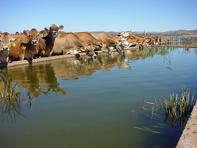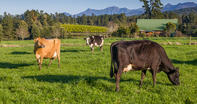The amount of milk a dairy cow will produce every day depends on her genetic merit and the feeding programme. Low quality feeds should not be fed to high genetic merit cows.

Milk production will be poor with cows losing body condition. They will become thin which will negatively affect their fertility.
Cows are fed forages like pasture, hay or silage. The feeding value of forages differs ranging from poor (straw) to high (cultivated pastures). The milk yield of cows on straw will be poor and higher on cultivated pasture.
Pasture vs Zero-grazing Feeding Systems

In a pasture-based system, forages are harvested by the cows through their grazing. The amount of pasture available before grazing determines the milk yield of cows. Hay is fed in bales which weigh 12-25 kg each. Silage is collected from a silage bunker and is fed in a loose form. Silage is fresh grass or green fodder compacted and stored in airtight conditions.
Silage contains more moisture than hay; therefore a larger amount must be fed to ensure a similar dry matter intake as hay. Forage intake should be recorded once a week by weighing the amount being fed to cows and also weighing any leftover material. In a zero-grazing system, forage is fed to cows in feed troughs.
Breed and age of cows affect the amount to be fed daily, i.e. being higher for Holsteins than Jerseys while older cows require more feed per day than first lactation cows. The feed intake of Holstein cows ranges from 18-24 kg per day. Jersey cows, being smaller in size, require about 12-16 kg feed per day.